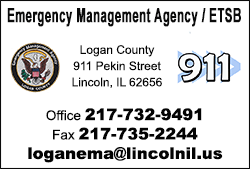|
National Weather Service - Lincoln:
Severe Weather Preparedness Week: March 4 - 10, 2018
 Send a link to a friend
Send a link to a friend
 [March 03, 2018] [March 03, 2018]
LINCOLN
A statewide Tornado
Drill will be conducted at 10:00 am Tuesday March 6th.
All NWS offices in IL will issue an actual Tornado Warning as a test
for all 102 counties in the state
The TEST warning will clearly state that NO SEVERE WEATHER is
occurring, and that we are doing this for test purposes
We don’t do this to scare people, but we do this to adequately test
the Emergency Alert System (EAS) that radio and TV broadcasters use
to warn the public of hazardous weather. This is also done to verify
that people using weather alert radios can receive an actual tornado
warning.
This has been done for more than 30 years – every first Tuesday in
March at 10 am.
Use of an actual Tornado Warning for this test has been approved by
NWS Headquarters, the Federal Communications Commission (FCC) and
the Illinois Broadcasters Association (IBA)
The main themes for this year’s Severe Weather Preparedness Week
are:
It is VERY important for people to be prepared for floods,
tornadoes and severe thunderstorms all year in the state of
Illinois.
-
If flooding is
occurring or imminent you may need to evacuate your home
quickly. Remember the dangers of driving on flooding roads.
TURN AROUND…DON’T DROWN!
-
In the event of a
tornado, go to the basement under a sturdy piece of furniture or
the stairwell. Otherwise, go to the lowest level in a small
area, like a closet, interior hallway or bathroom without
windows.
-
Everyone needs to
have a plan in mind regarding WHERE they would seek shelter from
tornadoes and severe storms at home, work, and any location
where people gather
-
Check your
insurance policies and make any necessary adjustments in the
event you might suffer storm or flood damage
-
Have an Emergency
Supply Kit with extra clothing, money, water, non-perishable
foods, medications, tools and flashlights

Do NOT just rely on
outdoor warning sirens to alert you that a tornado or severe
storm is approaching. Have multiple ways to receive information such
as:
-
Weather Alert Radio
-
Portable radio with battery backup
-
Wireless Emergency Alerts on most smart phones
-
Cell
phone apps that will send you warnings for your area
-
Local TV and radio stations
Severe Weather
Impacts
The United States experiences more tornadoes than any other country
in the world! An average of nearly 1,400 tornadoes impact the U.S.
every year.
Illinois averages about 50 tornadoes each year. Last year, 50
tornadoes were reported in Illinois resulting in 3 fatalities, 16
injuries and causing more than
$12 Million in property damage.
Tornadoes in Illinois have killed 228 people, and injured more than
4,500 since 1950
The biggest tornado outbreak in Illinois since 1950 occurred on
April 19, 1996. A total of 39 tornadoes were reported on that day,
including four F3 tornadoes. One person was killed, 74 people were
injured, and property damage exceeded $100 Million.
High wind from downbursts and straight-line winds cause more damage
than nearly 75% of the tornadoes that occur in Illinois! Illinois
averages around 550 reports of thunderstorm related wind damage each
year.
29 people have died from damaging winds in Illinois since 1995.
Since 2000 there have been more than 270 people injured in Illinois
from severe thunderstorm wind gusts.
Central / Southeast Illinois Severe Weather Statistics
Of the top 20 counties with the most tornadoes in the state, 10 are
in
central or eastern Illinois. These are:
-
Logan (ranked #2)
-
Tazewell (#3)
-
Sangamon (#4)
-
McLean (#5)
-
Woodford (#6),
-
Macon (#11)
-
Champaign (#12)
-
Piatt (#14)
-
Douglas (#16)
-
Vermilion (#17).
[Data based on tornadoes per square mile
from 1950-2017]
In the past 10 years, 74% of all severe weather events (damaging
winds, tornadoes and large hail) in central and southeast Illinois
had advance warning by the NWS in Lincoln, with an average lead time
of 16 minutes.

Severe Weather Warnings
NWS Implementation of storm based warnings for smaller areas, and
portions of counties, has resulted in a 79% reduction of false
alarms across central and eastern Illinois since 2008.
Since 2013, NWS offices have put enhanced wording in all Tornado
Warnings.
-
This is intended to
improve communications of the anticipated threats and impacts of
tornadoes. Specific information in the warning will highlight
the tornadoes that are expected to produce, or confirm the
occurrence of, considerable or catastrophic damage.
Talking Points for 2018 Severe Weather Preparedness
Tornadoes Fast Facts
Illinois ranks fifth in the United States for the most tornadoes per square mile
The majority of Illinois tornadoes have occurred between April 1 and June 30 and
between the hours of 3 p.m. and 10 p.m. However, tornadoes have occurred every
month of the year at all hours of the day.
Nearly 30 percent of all tornadoes in Illinois occur after dark.
On average, 50 tornadoes occur each year in Illinois.
There were 50 tornadoes reported in Illinois during 2017, which resulted in 3
fatalities, 17 injuries and more than $12 million in property damage
In central and southeast Illinois there were 14 tornadoes in 2017. The strongest
was an EF-3 tornado which impacted the town of Washburn (Woodford/Marshall Co
line) on 2/28/17. The tornado stayed on the ground for nearly 20 miles.
The day with the most tornadoes in the state of Illinois in 2017? February 28th
into the early morning of March 1st. 17 tornadoes were reported – which was a
record for that time of year.
In Illinois since 1950:
-
78 percent of tornadoes have been
weak with wind estimated less than 110 mph,
-
21 percent of tornadoes have been
strong with wind estimated between 110-167 mph,
-
1 percent of tornadoes have been
violent with wind estimated greater than 167 mph. The last
violent tornado in Illinois occurred on April 9, 2015, from just
north of Rochelle to the village of Fairdale.

SAFETY During a Tornado
Take the following actions when a Tornado Warning has been issued by the
National Weather Service, when sirens have been activated or when a tornado has
been sighted near your area:
Monitor a weather radio, radio, TV, weather app, or social media for the
latest weather information.
Go immediately to your predetermined shelter, such as a storm cellar,
basement or the lowest level of the building. In a basement, go under the
stairs, under a heavy piece of furniture or a work bench. Stay there until the
danger has passed.
If in a mobile home, get out and seek shelter elsewhere, well before the
storm arrives. A mobile home can overturn very easily even if precautions have
been taken to tie down the unit. If there is not a substantial shelter nearby,
go to a low-lying area and shield your head with your hands.
[to top of second column] |

If there is no basement, go to an interior hallway or a small interior
room without windows, such as a bathroom or closet. Stay away from outside
windows and walls as they may be penetrated by high speed, wind-borne debris.
Get under a piece of sturdy furniture, such as a workbench or heavy
table, and hold onto it. If sturdy furniture is not available, make yourself the
smallest target possible. Squat low to the ground. Put your head down and cover
your head and neck with your hands.
Use pillows, mattresses or cushions to protect your head and neck.
Outdoors:
If possible, get inside a substantial building on the lowest floor, away
from windows and doors.
If an indoor shelter is not available or there is no time to get indoors,
then, as a last resort, lie in a ditch or culvert. Use your arms to protect your
head and neck. Beware of the potential for flash flooding.

In a Vehicle:
Do NOT park under a bridge or overpass! The embankment under an overpass
is higher than the surrounding terrain, and the wind speed increases with
height. Additionally, the overpass design may create a wind-tunnel effect under
the span, further increasing the wind speed. Many overpasses are completely
exposed underneath, and most lack hanging girders or a crawlspace-like area to
provide sufficient protection from debris, which can travel at high speeds even
in weak tornadoes. People stopping underneath overpasses block the flow of
traffic, putting others in danger.
Immediately exit the vehicle in a safe manner and take shelter in a
nearby building.
Never try to outrun a tornado in a vehicle. Heavy rain, hail and traffic
may impede your movement. Tornadoes can change directions quickly and can easily
lift up a vehicle and toss it through the air.
As a last resort, if there isn’t time to get indoors or if there is no
secure shelter nearby, lie flat in a ditch, culvert or low-lying area away from
vehicles.
Severe Thunderstorms & Lightning
Fast Facts
Illinois averages 550 reports of wind damage and large hail annually. Too often,
people ignore severe thunderstorms because they believe only a tornado will
cause damage or threaten their lives. The fact is a majority of the property
damage and injuries each year is from high winds and large hail.
Severe thunderstorms can produce tornadoes, damaging winds, lightning, hail
and/or heavy rain
High wind from straight-line winds and downbursts can cause more damage than
nearly 75 percent of the tornadoes that occur in Illinois
One of the largest hailstones ever reported in Illinois fell near Minooka
(Kendall County) on June 10, 2015. The hailstone was 4.75 inches in diameter,
which is bigger than a grapefruit! Damages in excess of $100,000 were reported
with this hailstorm.
Most lightning deaths occur under or near trees and in open fields
Illinois ranks 8th in the U.S. for the most lightning strikes per square mile
each year
Lightning is to blame for 105 deaths in Illinois since 1960

SAFETY During A Severe Thunderstorm and/or lightning
It is critical that someone at home, work or wherever people gather monitors
weather conditions, regardless of the time of day. Monitor watches and warnings
in your areas using a weather alert radio, cell phone app, local TV, local radio
or the Internet. If it is safe to do so, contact family members and friends when
you become aware of a severe thunderstorm and/or lightning that may threaten
them.
Check the weather forecast before leaving for extended outdoor periods and
postpone plans if severe weather is imminent.
At Home and Work:
Monitor the radio, television or Internet for the latest weather information
Stay away from all windows and exterior doors during the storm. If you can do it
safely, draw the window shades or blinds to reduce the risk from flying glass
shattered by high winds.
Turn off air conditioners. In the event of a lightning strike, a power surge
could damage the compressor
Delay taking baths or showers until after the storm passes due to the lightning
threat
Outdoors:
If outdoors, seek shelter immediately. If you can hear thunder, you are
close enough to the storm to be struck by lightning.
If you find yourself in a position where there is no immediate shelter
available, find a low spot away from trees and power poles
If you are in a boat when a thunderstorm threatens, you should attempt to reach
shore as quickly as possible
If you are driving, pull safely to the shoulder away from trees and power
lines. Lightning can flash from trees or power poles and strike a vehicle.
Rubber tires do NOT keep lightning from striking a vehicle. In the open, a
hard-topped vehicle is normally a safe shelter from lightning. Avoid touching
metal parts of the vehicle when lightning is nearby.
Flooding Fast Facts
Fourteen people died as a result of driving across flooded roads in 2015, 11 of
whom perished during the major flood in late December. This was the highest
annual number of flood fatalities since records have been kept.
Prolonged flooding from creeks and rivers and flash flooding from rain swollen
roads and waterways are dangers that too many people ignore, sometimes with
fatal consequences. Many flood-related rescues, injuries and fatalities have
been the result of people in vehicles attempting to drive across flooded roads.

The most dangerous type of flooding is a flash flood. Flash floods can sweep
away everything in their path.
Most flash floods are caused by slow-moving thunderstorms and occur most
frequently at night.
Flooding has been a factor in 49 deaths across Illinois since 1995. This is more
than the number of people killed by tornadoes during the same period. Most of
these flood fatalities involved people in vehicles trying to cross flooded
roads.
During a Flood
Monitor a weather radio, radio, TV or Internet for the latest weather
information and evacuation instructions
If advised to evacuate, do so quickly.
Evacuation is much simpler and safer before flood waters become too deep for
ordinary vehicles.
Follow recommended evacuation routes. Short cuts may be blocked.
Move valuable household possessions to an upper floor or another location if
flooding is imminent and time permits.
If instructed to do so by local authorities, turn off utilities at their source.
Many people have lost their lives by attempting to drive over flooded roadways.
The speed and depth of the water is not always obvious. There may be a hidden
portion of the roadway washed out under the water. Two feet of water will carry
away most automobiles.
Severe Weather Preparedness
• The National Weather Service’s goal is to build a “Weather Ready Nation”. The
purpose of this initiative is to save lives as well as livelihoods. By
increasing the nation’s weather readiness the country will be better prepared to
protect, mitigate, respond to, and recover from weather-related disasters.
Visit our website at: www.weather.
gov/Lincoln for the latest weather and river forecasts, warnings,
current conditions, radar & satellite imagery, and climate information.
[Chris Miller, Warning Coordination
Meteorologist
National Weather Service - Lincoln] |